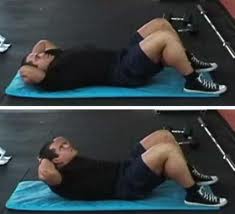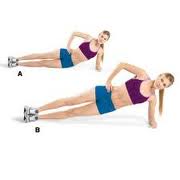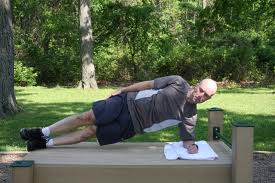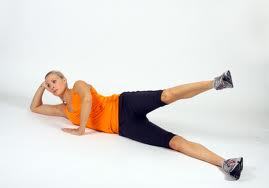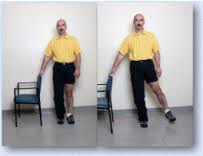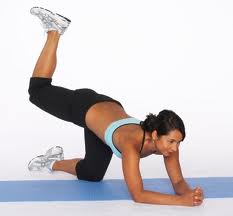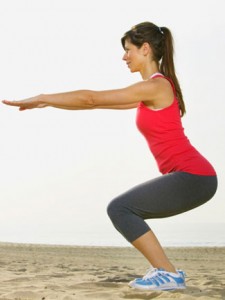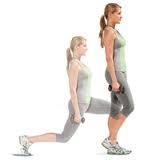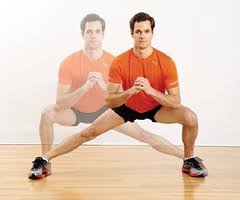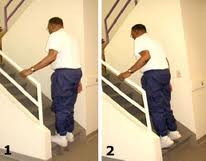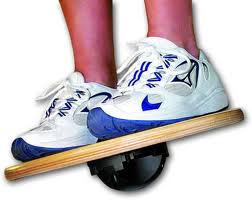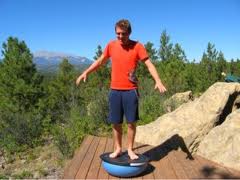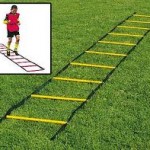Agility ahttp://forever-active.com/wp-admin/plugins.phpnd balance training is not just for older adults who are the most vulnerable to injuries related to falls. Recent research has indicated that agility balance training has positive benefits for all age groups including the competitive and recreational athlete.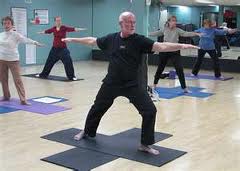
In older age groups, there is a gradual decline, as a function of ageing, in sensory (eyes and ears), motor (muscles, tendons and joints), and cognitive (reasoning, memory) function which affects this population’s ability to maintain good agility and balance as they move and change position. As a result, falls resulting in fractured wrist, shoulders and hips are a frequent occurrence. However, in the general population, because of previous injury to joints such as ankles, hips and lower back and shoulders, a lack of muscle strength and endurance in the legs due to a lack of physical activity and mental fatigue and emotional stress from work and family life, a younger person’s agility and balance can be compromised as well, and this can have a big effect on that person’s ability to perform athletically and maintain an active lifestyle.
Interestingly, research has shown that high intensity, highly specific agility and balance training is not necessary to have a positive impact on improving someone’s balance. Research suggests that a minimum of 10 minutes of low intensity training three days per week for 4 weeks is sufficient to improve static and dynamic ( your centre of gravity is moving) balance.
Two factors that contribute to agility and balance are;
1. Core and Lower body muscle strength. Exercises that strengthen your core (abdominal area and back), hips (Buttocks) and legs (quads, hamstrings and calves) will improve agility and balance by giving you the strength to move with more rhythm and coordination and maintain balance and make corrections when you fall off balance. Muscular resistance exercises such as abdominal crunches, back extensions, leg extensions and leg curls, squats, and lunges are important. These exercises can be done on either a stable surface such as a floor or on unstable surface like a wobble board. Agility exercises using an agility ladder is also an excellent way to improve leg strength and balance.
2. Timeliness of neurological signals to the muscles. Agility drills can help train your brain to signal your muscles more quickly to move and make balance corrections when necessary to avoid falling.
The most important point to remember is that good agility and balance is necessary for people of all ages and fitness levels for injury prevention, the ability to effectively carry out activities of daily living such as stair climbing, bending and lifting, and to enjoy participating in physical activities such as golf, bike riding, skating, gardening and walking. Simple, non strenuous exercises focusing on core, leg strength, agility and balance 3x’s / week can have tremendous effect on improving this component of your fitness and health.
levels for injury prevention, the ability to effectively carry out activities of daily living such as stair climbing, bending and lifting, and to enjoy participating in physical activities such as golf, bike riding, skating, gardening and walking. Simple, non strenuous exercises focusing on core, leg strength, agility and balance 3x’s / week can have tremendous effect on improving this component of your fitness and health.
Tables 1, 2 and 3 below illustrate muscular strengthening exercises, balance exercises and agility exercises that can easily be implemented at home to improve your lower leg strength and your agility and balance. When performing these exercises, as with any new exercise routine, it is important to start slowly, focus on doing them biomechanically correct and increase the number of repetitions or length of the exercise only after you can perform them without significant fatigue or muscle soreness.
These exercises should be become part of everyone’s exercise routine.
Table 2: Balance Exercises to Improve Stability
Notes:
- Balance exercises should not be attempted until you have completed 4 to 6 weeks of muscular resistance exercises (Table 1) to ensure adequate core and leg strength.
- When you are doing each balance exercise try to keep your core tight (abdominals tucked in) and feel your hips and buttocks muscles working to keep you stable. The goal is to minimize swaying as you perform each exercise.
- The following balance exercises are in order of increasing difficulty and can be can be made more challenging (progression) by changing your feet position or the stability of the surface you are standing on (wobble board or Bosu). Only progress to the next level of instability when you can safely complete the series of balance exercises without significant swaying or fatigue.
Levels of Progression
- Feet shoulder or hip width apart.
- Staggered Step Position- one foot takes a step forward.
- Split position 1 – one foot is one step ahead but directly in front of the back foot.
- Split position 2 –same as split position 1 but heel of forward foot is touching the toe of the back foot.
- Stand on single leg.
- Stand on unstable surface (wobble board or Bosu).
Wobble Board Bosu
Progressive Balance Exercises
– Progress so you can hold each position for 10-20 sec or can do 10 reps of each exercise.
– To add an additional level of difficulty you can do each exercise with your eyes closed.
| Standing on Both Legs; |
Progression;
|
2. Raise a finger in front of your eye and follow it with your eyes as you move it up and down and to the sides.Progression;
|
| Standing on one leg; |
| 1. Swing leg forward and back with the opposite arm swing in opposite direction of the leg.Progression;As your arm swings forward you reach down and touch the floor (reverse lunge). The swinging leg does not touch the floor. |
| 2. Swing leg out to the side and then across the body. The opposite arm swings in the opposite direction of the leg.Progression;As the leg swings out you do a squat. |
| 3. Swing leg out to the side and then across in front of the body and then around and across the back of the body. The opposite arm swings in the opposite direction of the leg.Progression;As leg swings around and crosses the back of the body do a squat. The back toe may touch the floor if necessary. |
| For an illustration of the balance exercises just described view the following video;http://www.youtube.com/watch?v=AWuKEt96Jjs |
Table 3: Agility Exercises to Improve Agility and Balance
Agility exercises are basically dynamic (your centre of gravity is moving horizontally) balance exercises. They are an advanced form of balance exercises and require a greater amount of leg strength and neurologic coordination than static balance exercises in table 2.
As with static balance training, remember to start simple and slowly increase the complexity. All movements should be slow in the beginning and increase in speed when progression is appropriate. Never overestimate your skill level when increasing the level of difficulty. Progress slowly.
To begin dynamic balance/agility activities, find a flat, soft surface. Perform each agility exercise by moving a specific distance forward and then the same distance backward.
Key Point–
Recovery time between agility exercises should be between 45 to 60 seconds. As you progress you can reduce recovery time to 30 or 15 sec.
Key Points :
- Progress slowly.
- The most important point in dynamic balance training is to master proper form, not speed.
- To make the agility exercises more difficult as you progress, increase the speed and/or distance.
- For the older adult, focus on maintaining good balance when performing the agility exercises
- For the athlete, focus on mimicking movements essential to your sport of choice. For example, if you are a soccer player, incorporate more side-to-side movements. If you are a golfer, focus on how to maintain balance while moving.
The agility exercises illustrated below can be used with or without an agility ladder.
Agility Ladder
Agility Exercise Evaluation Chart
Agility exercises are listed below in chart form. You can use the chart to grade yourself on how proficient you are at performing the various drills.
It is not necessary to perform each of the exercise. You may pick and choose as you progress down the list. Under each category the exercises progress from easy to hardest.
Example of a Agility Workout:
Note– Start with 3 reps of each exercise and progress depending on your proficiency.
|
Workout #1 |
Workout #2 |
| 1. In In Out Out Lateral2. Cross-over Lateral3. Both feet every square hop sideways4. 2 Feet Wide then Narrow Hop Scotch5. 90° Rotation | 1. Carioca with two feet in each square.2. 1 leg every square hop forward.3. 2 Feet Diagonal Hop.4. Serpentine.5. Lateral Scissors Every Square Twice |
|
Test |
No Hesitation/Stumbles/ Difficulties |
Moderate Hesitation/ Stumbles/ Difficulties |
Significant Hesitation/Stumbles/ Difficulties |
| Walking Drills (Forward, sideways and cross over):One Foot in Each square walking forward(Start at end of ladder facing forward) |
|
|
|
| Both Feet in Each square walking forward(Start at end of ladder facing forward) |
|
|
|
| One foot in each square walking sideways(Start at end of ladder facing sideways) |
|
|
|
| Two feet in each square walking sideways(Start at end of ladder facing sideways, inside legs starts) |
|
|
|
| In In Out Out going laterally(Start at side of 1st sq. facing the ladder, inside leg starts) |
|
|
|
| In Out Out going laterally(Start at side of 1st sq. facing the ladder, start with outside leg going in and then alternate the leg going forward) |
|
|
|
| Cross-over Lateral(Start at end facing sideways)(Outside foot is the Leading Cross over foot and always crosses in front) |
|
|
|
| Carioca with two feet in each square(Start at end facing sideways)(Outside foot is the leading crossing foot and alternates going in front and then behind) |
|
|
|
| Carioca with only one foot in each square(Same as above but only one foot per square) |
|
|
|
| Ickey Shuffle (no crossing over of legs)(Start at side of 1st sq. facing forward-inside leg moves sideways followed by outside leg, 1st leg then moves diagonal to outside of 2nd sq. and other foot moves forward into the 2nd square & then the 1st leg moves laterally into the 2nd sq. & then repeat the sequence with the 2nd foot moving diagonal outside the 3rd square,etc.). |
|
|
|
|
Test |
No Hesitation/Stumbles/ Difficulties |
Moderate Hesitation/Stumbles/ Difficulties |
Significant Hesitation/Stumbles/ Difficulties |
| Cross-over Zig Zag (legs are always crossing over)(Start at L side of 1st sq. facing forward and cross outside leg over in front of inside leg into 1st sq. Inside leg then crosses behind the 1st leg into the 1st sq. & then 1st leg crosses again to opposite side of 1st sq followed by the 2nd leg crossing behind the 1st & the 2nd leg (outside leg) crosses 1st leg into the second sq., etc.) |
|
|
|
| Forward Hop Drills:(Each Starts at end facing forward)Both feet every square hop forward |
|
|
|
| Both feet every other sq. hop forward |
|
|
|
| 1 leg every square hop forward |
|
|
|
| 1 leg every other square hop forward |
|
|
|
| Sideways Hop Drills:(Each starts at end facing sideways)Both feet every square hop sideways |
|
|
|
| Both feet every other square hop sideways |
|
|
|
| Start with one leg in each sq. and hop sideways into each square |
|
|
|
| Start with one foot in each sq. & hop sideways into every other square |
|
|
|
| 1 Foot hop sideways into each square |
|
|
|
| 1 Foot hop sideways into every other square |
|
|
|
| Sideways Hopping/Diagonal Drills:2 Feet Sideways & Diagonal Hop(Start L side of 1st sq. facing forward) Both feet hop sideways into every square & when at outside of sq. hop diagonally forward into the next sq. & then hop to the outside, etc. |
|
|
|
| 2 Feet Diagonal Hop(Start at L outside end of the ladder, hop diagonally into the 1st sq and then to the outside of the 2nd sq & then into the 3rdsq., etc.) |
|
|
|
| 2 Feet Hop Scotch every other sq. of the ladder(Start at the end facing forward)(Do a hop scotch with the feet going into every other square). |
|
|
|
|
Test |
No Hesitation/Stumbles/ Difficulties |
Moderate Hesitation/Stumbles/ Difficulties |
Significant Hesitation/Stumbles/ Difficulties |
| 2 Feet Wide then Narrow Hop Scotch(Start at the end facing forward)(Do a hop scotch, feet go wide at first and then feet go into the sq. of the ladder. No sq is missed) |
|
|
|
| 2 Feet Hop Sideways Once & Then Diagonal Hop to the same outside that you started (ie-L side) (Start at L side of 1st sq. facing forward) |
|
|
|
| 2 Feet Diagonal Hop (Start in 1stsq. facing forward)You will hop into Every Other Square as you hop forward diagonally |
|
|
|
| Side to Side Scissors Hop (Start at end facing forward with feet parallel)(Scissor hop – as you hop one foot is in a sq and one foot out of sq.- alternate sides that the one foot is out. Each sq will have an alternate foot in it) |
|
|
|
| Forward Scissors in the Squares(Start at end with one foot in a sq. and one foot out )(the lead foot stays in the square as you scissor hop) |
|
|
|
| One foot Side to Side Hop(In & Out)(Start with the hopping foot in the 1st sq. facing forward & hop outside of 1st sq & then into 2nd sq. & then outside of 2nd sq, etc.) |
|
|
|
| One foot Diagonal Hop(Start at end of ladder on one foot and hop diagonal to outside of 1st sq. and then into the 2nd sq. and then outside of 3rd sq, etc. If you are using L leg to hop stay on L side of ladder & vise versa) |
|
|
|
| Lateral Hopping / Diagonal Drill:Two Feet Front to Back (sideways) & Diagonal Hop(Start with both feet in 1st sq. and face sideways & hop to the outside (sideways) & then back to the 2nd sq. diagonally & then forward (sideways) again etc.) |
|
|
|
| Two feet Front to Back Diagonal Hop(Start in 1st sq. facing sideways and skip a sq as you hop diagonally in and out. You will be outside of 2nd sq. and inside 3rd sq. and outside 4thsq. etc) |
|
|
|
|
Test |
No Hesitation/Stumbles/ Difficulties |
Moderate Hesitation/Stumbles/ Difficulties |
Significant Hesitation/Stumbles/ Difficulties |
| Two Feet Front to Back Sideways Across the Ladder Hop(Start at side of 1st sq. facing sideways and hop to other side (outside) of 1st sq. & then hop diagonally backward to outside of 2nd sq.) |
|
|
|
| Two Feet Front to Back Diagonal Hop(Start at side of 1st sq. facing sideways and hop diagonally to outside of 2nd sq. & then to outside of 3rdsq., etc.) |
|
|
|
| Two Feet Every Square Diagonal Hop(Start in 1st sq facing sideways & hop forward & then hop backwards into 2nd sq. and then backwards to outside of 2nd sq, etc) |
|
|
|
| One foot In & Out Every Square Hop(Start with the one leg in the 1st sq. facing sideways and then hop forward to outside of 1st sq. & then hop backward into 2nd sq & then forward again to outside of 2nd sq., etc.) |
|
|
|
| One Foot In & Out Every Other Square Hop(Start with the one leg in the 1st sq. hop to outside of 2nd sq. & then back into 3rd sq & then outside of 4th sq., etc.) |
|
|
|
| Rotational Response Drills:90° Rotation(Start at end of 1st sq. facing sideways & then hop into 1st sq & rotate 90ᵒ so you are facing forward & then hop into 2nd sq. & rotate another 90ᵒ, etc) |
|
|
|
| 180° Rotation(Same as above but you rotate 180ᵒ with each hop) |
|
|
|
| 90° Rotation Forward Foot in Same Sq. Twice(Start with one foot in the 1st sq. & one foot outside of 1st sq. facing forward and hop so one foot is still in 1st sq and other is in 2nd sq & rotate 90ᵒ at same time so you are facing sideways & then hop so foot stays in 2nd sq but other foot that was in 1st sq is now outside the 2nd sq. & you rotate back 90ᵒ so you are facing forward again, etc.) |
|
|
|
| 90° Rotation Forward Foot in Same Sq. Twice Every Other Square(Same as above but forward foot stays in sq only for one hop and rotation not twice) |
|
|
|
|
Test |
No Hesitation/Stumbles/ Difficulties |
Moderate Hesitation/Stumbles/ Difficulties |
Significant Hesitation/Stumbles/ Difficulties |
| Serpentine(Same as above but you go from one side to the other (like a snake) so the one foot that is in the square will be in the sq. for three hops & each 90ᵒ rotations) |
|
|
|
| Lateral Scissors Every Square Twice(Start facing sideways with one foot in the 1st sq. & the other outside & scissors you legs so the opposite feet are in the 1st sq. You scissor each sq. twice so each foot is in each sq once) |
|
|
|
| Lateral Scissors Every Square Once(Same as above but you scissor so you are in each square only once) |
|
|
|
Summary
Leg strengthening, balance and agility exercises, should become part of everyone’s exercise routine. Doing these exercises frequently, at least twice a week, at low intensity, is more effective than doing them sporadically at high intensity to fatigue. It is getting into the routine of doing them regularly that is the key to improvement. Walking, riding a bike, skating, running, bowling, yoga, Pilates, tai chi or any other physical activity that requires core involvement, leg movement and coordination will help improve your agility and balance.
The secret is to use it or you will lose it so get started today.
Remember, “Success is in the Doing”.
If you’d like more info please contact Mike.

